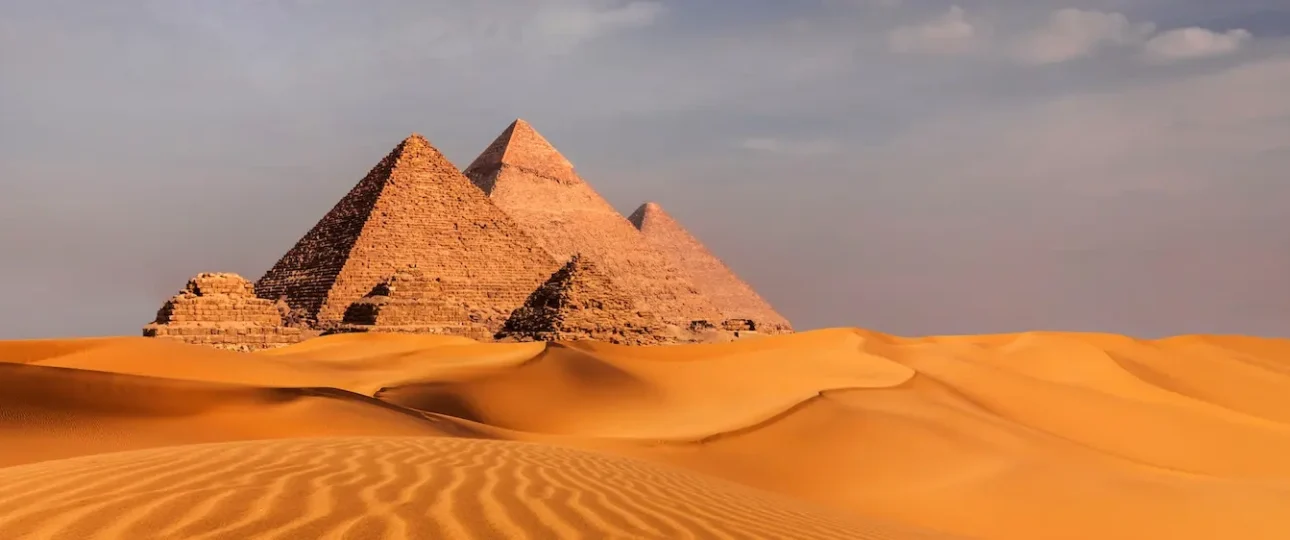Wonders of Ancient Egypt
Ancient Egypt, a land of captivating mysteries and timeless wonders, beckons travelers from across the globe to immerse themselves in its mesmerizing treasures. Each marvel holds a unique story, connecting us to a bygone era where pharaohs ruled with divine authority and architectural brilliance flourished. Join us on an enchanting journey as we unveil the seven wonders of Egypt, where history comes alive, and emotions intertwine with awe-inspiring beauty.
The Great Pyramid of Giza: A Testament to Ancient Ingenuity
As the sun rises over the horizon, casting its golden rays upon the ancient sands of Giza, the Great Pyramid stands tall as an enduring symbol of ancient ingenuity. Constructed over 4,500 years ago as the burial place of Pharaoh Khufu, this colossal structure continues to defy the test of time, leaving us in wonder and amazement at the sheer precision and skill of the architects who crafted it without modern tools. To gaze upon this ancient wonder is to stand witness to a civilization’s extraordinary achievements.
The Great Pyramid of Giza, also known as the Great Pyramid of Khufu, is the largest of the three Pyramids of Giza, situated on a rocky plateau on the west bank of the Nile River in northern Egypt. Built by Khufu, the second king of Egypt’s 4th dynasty, the pyramid was completed around 2560 BCE. The Pyramids of Giza are often collectively considered one of the Seven Wonders of the World, and they are the last of the wonders still standing.
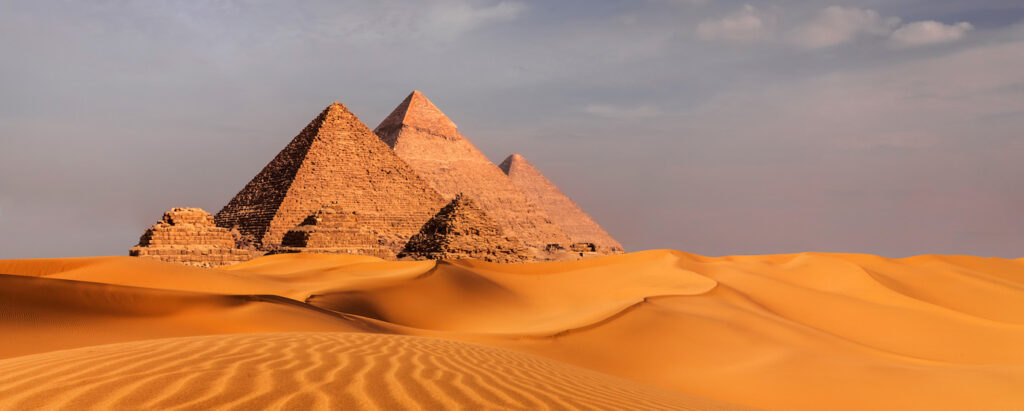
Questions about the construction of the Great Pyramid persist to this day. The most plausible theory suggests that the Egyptians employed a sloping and encircling embankment of brick, earth, and sand, which was increased in height and length as the pyramid rose. Stone blocks were hauled up the ramp by means of sledges, rollers, and levers. According to the ancient Greek historian Herodotus, the Great Pyramid took 20 years to construct and required the labor of 100,000 men. However, more recent evidence suggests that a more limited workforce may have occupied the site on a permanent basis. It was suggested that as few as 20,000 workers, along with support personnel such as bakers, physicians, and priests, would have been adequate for the task.
Excavations of the Great Pyramid began in the 19th century, with notable discoveries, such as laborers’ graffiti indicating the pyramid belonged to Khufu. Formal excavations later revealed two boats buried near the Great Pyramid, though the king’s remains have never been found. In recent times, 3D scanners and noninvasive technologies have been utilized to explore the pyramid, leading to the discovery of a hidden corridor in 2023.
The Enigmatic Sphinx: Guardian of the Pyramids
Majestically guarding the Giza Plateau, the Sphinx has been a sentinel of mysteries for millennia. Its imposing lion’s body and the enigmatic smile of Pharaoh Khafra’s face spark our curiosity and ignite our imagination. As the wind whispers through the desert, we can almost hear the secrets it holds, tantalizing us with stories lost in the sands of time. The Sphinx remains an emblem of ancient power and a testament to the rich tapestry of Egyptian mythology.
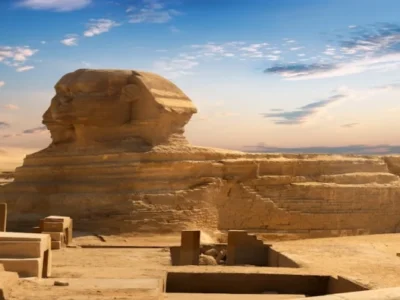
The sphinx is a mythological creature with a lion’s body and a human head, holding an important place in both Egyptian and Greek art and legend. The most famous sphinx in legend was the winged sphinx of Boeotian Thebes, said to have terrorized the people by demanding the answer to a riddle taught to her by the Muses. Only when Oedipus gave the correct answer did the sphinx take her own life. The wisdom of the sphinx became proverbial, and its image persisted in Greek art and culture.
Valley of the Kings
The Valley of the Kings, also known as the Valley of the Tombs of the Kings, is a long narrow defile located just west of the Nile River in Upper Egypt. It was part of the ancient city of Thebes and served as the burial site for almost all the kings (pharaohs) of the 18th, 19th, and 20th dynasties, spanning from Thutmose I to Ramses X. The valley is situated in the hills behind Dayr al-Baḥrī, and the 62 known tombs exhibit variety in plan and decoration.
Fearing for the safety of their rich burials, the kings of the New Kingdom adopted a new plan of concealing their tombs in a lonely valley in the western hills behind Dayr al-Baḥrī. There, deep into the heart of the mountain, pharaohs were interred, along with several queens, high-ranking officials, and the numerous sons of Ramses II. The tombs’ plan varied considerably but essentially consisted of a descending corridor interrupted by deep shafts to thwart robbers, leading to pillared chambers or vestibules. At the farther end of the corridor was a burial chamber with a stone sarcophagus in which the royal mummy was laid, surrounded by store chambers containing furniture and equipment for the king’s use in the afterlife.
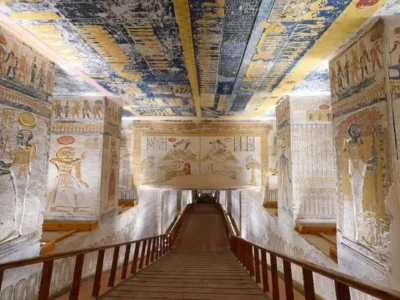
The walls of the tombs were adorned with sculptured and painted scenes depicting the dead king in the presence of deities, particularly the gods of the underworld, along with illustrated magical texts to aid the king on his journey through the nether regions.
The little tomb of Tutankhamun, located on the floor of the valley, miraculously escaped pillage and revealed a wealth of treasures when discovered in 1922. The tomb of Queen Hatshepsut, the longest tomb in the valley, is nearly 700 feet from the entrance and descends 320 feet into the rock.
Temples of Karnak: A Vast Complex of Timeless Beauty
Karnak houses the northern group of Theban city temples, known in ancient times as Ipet-Isut, meaning “Chosen of Places.” The ruins, covering a considerable area, are still impressive, though the houses, palaces, and gardens that once surrounded the temple precinct are now gone. The most northerly temple, the Temple of Mont, dedicated to the war god, retains only its foundations. The southern temple, devoted to the goddess Mut, wife of Amon, is much ruined and features a horseshoe-shaped sacred lake.
The temple was built during the reign of Amenhotep III by his architect, commemorated by statues in the Temple of Mut. The complex comprises pylons leading toward the Nile and processional gateways linking the temple with the Temple of Mut to the south and the Temple at Luxor, located 2 miles away, by way of an avenue of sphinxes.
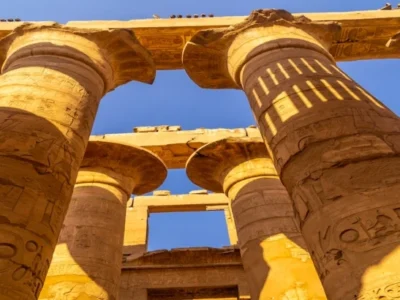
The most striking feature of the temple is the hypostyle hall, situated between the third and second pylons. This vast hall, considered one of the wonders of antiquity, covers an area of about 54,000 square feet. Decorated by Seti I and Ramses II, the hall boasts twelve enormous columns, nearly 80 feet high, supporting the roofing slabs of the central nave above the rest to allow light and air to enter through a clerestory. The outer walls feature historical reliefs depicting the victories of Seti in Palestine and Ramses II defeating the Hittites at the Battle of Kadesh.
Within the enclosure of the Great Temple of Amon are a number of other notable small shrines and temples, including a temple to Ptah, built by Hatshepsut and Thutmose III, and embellishments by the Ptolemies.
The Magnificent Temple of Abu Simbel: A Tribute to Pharaoh Ramses II
Abu Simbel, home to two temples built by Pharaoh Ramses II, reigns as a remarkable site in ancient Egypt. The four colossal statues of Ramses in front of the main temple stand as spectacular examples of ancient Egyptian art. Through a complex engineering feat in the 1960s, the temples were salvaged from the rising waters of the Nile River, caused by the construction of the Aswan High Dam.
The seated figures of Ramses, each standing at 66 feet, are set against the recessed face of the cliff, two on either side of the entrance to the main temple. The temple itself, dedicated to the sun gods Amon-Re and Re-Horakhte, comprises three consecutive halls extending 185 feet into the cliff, decorated with Osiride statues of the king and scenes of his victory at the Battle of Kadesh. On two specific days of the year, the first rays of the morning sun penetrate the entire length of the temple, illuminating the shrine in its innermost sanctuary.
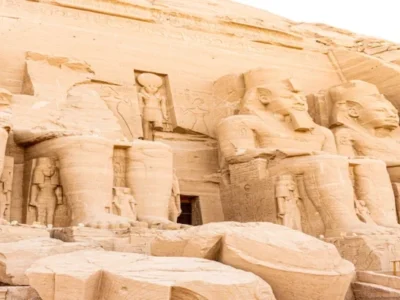
Just to the north of the main temple lies a smaller one, dedicated to Nefertari for the worship of the goddess Hathor, adorned with statues of the king and queen standing at 35 feet.
In the mid-20th century, when the nearby Aswan High Dam threatened to submerge Abu Simbel, UNESCO and the Egyptian government collaborated on a project to save the site. The temples were completely disassembled and reconstructed on higher ground, with more than 16,000 blocks moved. In 1979, Abu Simbel, along with Philae and other nearby monuments, were designated a UNESCO World Heritage site.
The Egyptian Museum: An Unparalleled Collection of Ancient Artifacts
The Egyptian Museum in Cairo houses a treasure trove of artifacts that illuminate the splendor of the ancient civilization. Stepping through its grand halls, visitors are transported back in time, surrounded by relics that echo history’s whispers. Among its precious exhibits, the golden mask of Tutankhamun stands as a beacon of the past, reflecting the artistry and craftsmanship of a revered civilization.

Founded in 1858 at Būlāq by the French Egyptologist Auguste Mariette, the Egyptian Museum moved to its present site in downtown Cairo in 1897–1902. Designed by French architect Marcel Dourgnon in Neoclassical style, it became the first purpose-built museum in the Middle East and North Africa. The museum’s presentation of Egypt’s entire history is truly unique, attracting countless enthusiasts, scholars, and history buffs from around the world.
The Sahara Desert: A Natural Wonder of Epic Proportions
Beyond the ancient wonders, the Sahara Desert spreads its vast expanse, embodying the raw beauty of nature. The shifting sand dunes and boundless horizon stir our souls, reminding us of the world’s profound mysteries. Egypt’s claim to a portion of this awe-inspiring desert serves as a reminder that nature’s marvels rival even the most extraordinary human achievements.
Conclusion: An Unforgettable Journey into Egypt’s Past
In the land of the pharaohs, each wonder whispers tales of a civilization that shaped the course of history. The Great Pyramid of Giza, the Sphinx, the Temples of Karnak, the Valley of the Kings, the Temple of Abu Simbel, the Egyptian Museum, and the Sahara Desert – together, they create an extraordinary tapestry of human achievement and natural beauty.
As you set foot upon the ancient grounds of Egypt, emotions will surge through you, as the magic of the past captivates your heart. The wonders of ancient Egypt will leave you humbled, inspired, and forever connected to the rich heritage of this extraordinary civilization that continues to enchant and bewilder the world.
So, seize the opportunity to witness the marvels of ancient Egypt, for in doing so, you will embark on an odyssey of the senses, where history, beauty, and wonder converge in a symphony of emotions. Let the echoes of the past resonate within you and create cherished memories that will last a lifetime.

